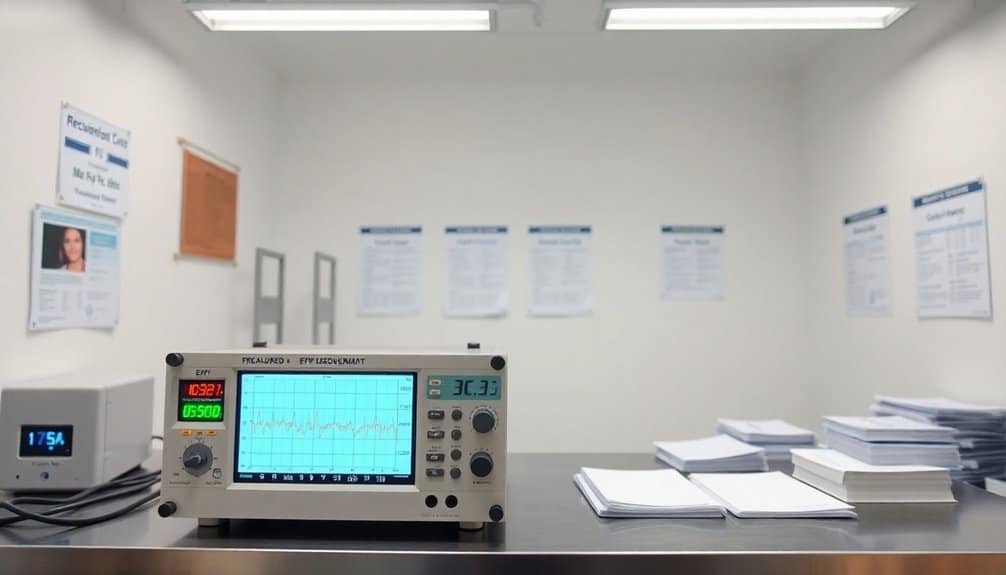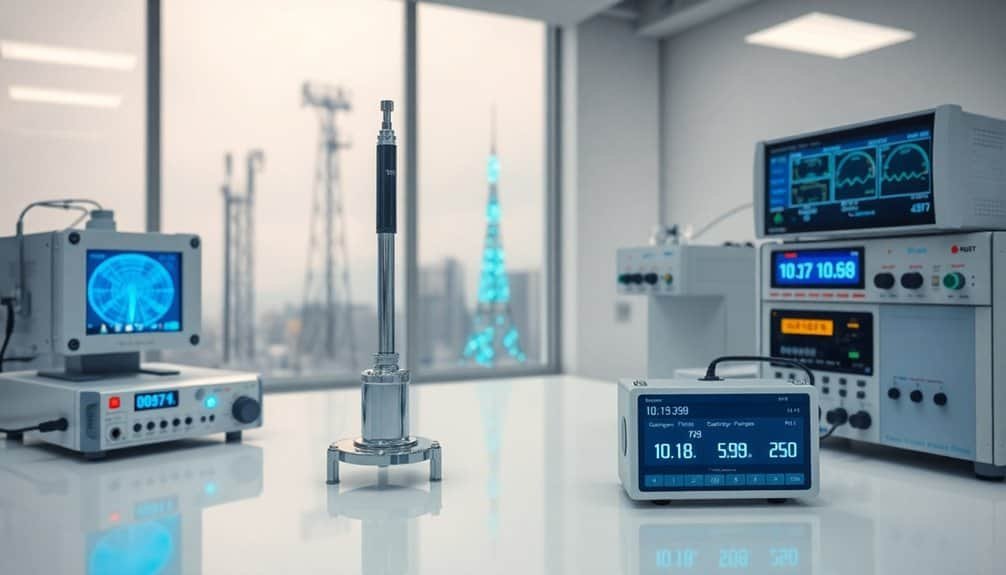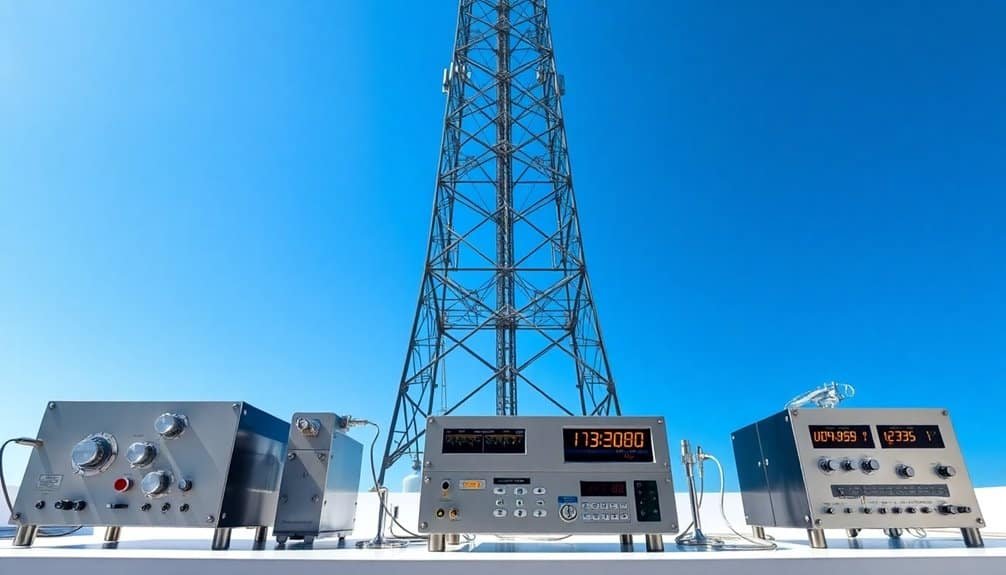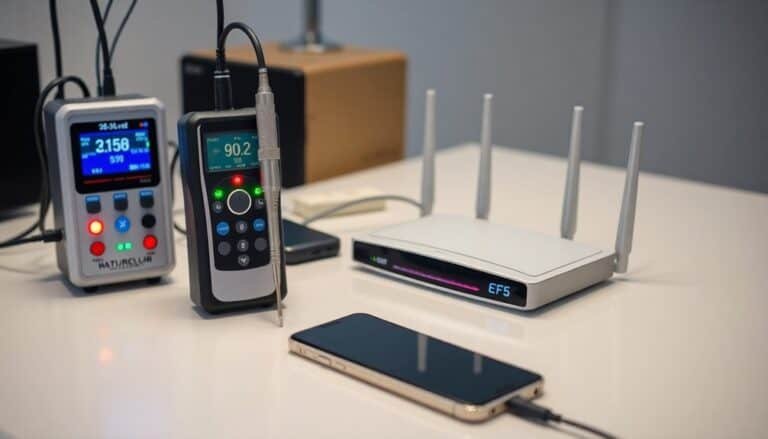The Role of Government Guidelines on EMF Safety
Government guidelines on EMF safety are essential for protecting public health by setting exposure limits for ELF and RF radiation. Agencies like the FCC and OSHA enforce these standards to ensure compliance in workplaces and public areas.
They recommend safety measures, such as PPE and engineering controls, to minimize exposure. Understanding these guidelines helps navigate EMF safety and stay informed about regulatory changes.
Disclaimer: As an affiliate, I may collect a share of sales from the links on this page.
Overview of EMF Regulations

While various electromagnetic field (EMF) regulations exist to protect you, understanding their nuances is essential.
Standards and guidelines specify exposure limits for Extremely Low Frequency (ELF) and radiofrequency (RF) radiation. Generally, these limits are set to prevent adverse health effects, often requiring exposure to be at or below one-tenth of the threshold specific absorption rate (SAR), such as 0.4 W/kg for RF. Electromagnetic induction is a crucial principle behind the generation of EMFs that regulators consider in setting these limits. Occupational exposure guidelines differ from general public guidelines to account for varying exposure durations and health risks.
Safety measures include personal protective equipment (PPE), engineering controls like barriers, and mandatory signage at high EMF levels.
Compliance with regulatory frameworks, such as IEEE C95.1, is vital for ensuring your safety around EMFs.
Key Government Agencies Involved in EMF Safety
Government agencies play a vital role in ensuring EMF safety across various sectors.
The Federal Communications Commission (FCC) regulates RF emissions, adopting guidelines from the NCRP and IEEE. The Environmental Protection Agency (EPA) monitors electric fields, particularly from power lines, while the Occupational Safety and Health Administration (OSHA) sets workplace exposure guidelines. The Food and Drug Administration (FDA) focuses on RF biological effects, and the National Institute for Occupational Safety and Health (NIOSH) investigates RF exposure issues. Increasing distance from EMF sources is an effective way to reduce exposure levels and enhance safety around these fields.
Collaboration among these agencies enhances public awareness and safety, assisting in the development of thorough EMF guidelines and regulatory frameworks.
Exposure Limits and Standards

Understanding exposure limits and standards for electromagnetic fields (EMFs) is essential for ensuring safety in various environments.
- Exposure limits cover 0 Hz to 300 GHz, as defined by IEEE C95.1-2019.
- ICNIRP suggests limits of 25 kV/m for electric fields and 40,000 µT for static magnetic fields.
- Occupational limits are stricter, often incorporating additional safety factors, like a factor of 5 for CNS.
- Public exposure limits usually include a safety factor of 2.
- Standards evolve, with updates reflecting new scientific evidence and technology advancements. The safety limits established are intended for individuals in unrestricted environments, helping to ensure public protection.
Adhering to these limits protects against established health risks associated with EMF exposure.
Safety Measures Recommended by Regulatory Bodies
Regulatory bodies recommend various safety measures to mitigate risks associated with electromagnetic field (EMF) exposure.
The FCC sets Maximum Permissible Exposure limits and specific absorption rate (SAR) guidelines. Employers must follow OSHA principles to guarantee workplace safety.
IEEE standards inform military and industrial settings about safe EMF levels. Safety signs, warning devices, and color coding alert personnel in high-risk areas. Approved personal protective equipment includes insulated gloves and shoes. Training on proper PPE use is essential.
Engineering controls, like barriers and interlocks, prevent accidental exposure, while public awareness programs educate communities on reducing EMF exposure effectively. Additionally, understanding EMF health risks is crucial for implementing these safety measures effectively.
Research and Findings on EMF Health Effects

Key findings highlight various concerns:
- EMF exposure may induce biological effects, like oxidative stress.
- Certain epidemiological studies link low-frequency fields to childhood leukemia.
- Research shows RF radiation can impact brain chemistry and the blood-brain barrier.
- Some individuals report symptoms attributed to EMF, though findings lack consistency.
- WHO and global initiatives endeavor to evaluate health risks objectively.
Recent studies emphasize that ionizing radiation poses significant health risks, including the potential for severe health effects leading to death.
Maintaining a balanced view is essential as investigation results continue evolving, influencing public perception and safety guidelines related to EMF exposure.
The Impact of Public Policy on EMF Safety
The formulation of public policy around EMF safety is critical for managing health risks associated with electromagnetic fields. Government policies, shaped by organizations like WHO, assess health effects and address rising public concerns. They establish exposure limits based on scientific reviews and risk assessments, steering conflicting studies and public pressure.
Policies also encourage international collaboration to create consistent regulations. Effective risk communication and public education are essential to alleviate fears and manage misconceptions. By balancing scientific evidence with economic implications, these policies aim to protect public health while accommodating technological advancements, ensuring a safer environment in the context of growing EMF exposure.
Compliance and Enforcement Mechanisms
Compliance and enforcement mechanisms play an essential role in guaranteeing that EMF safety guidelines are effectively applied. They help maintain public health standards and promote accountability among organizations.
Key aspects include:
- Exposure monitoring systems tracking EMF levels in sensitive areas
- Post-market surveillance of devices to guarantee compliance
- Facility registries for managing EMF sources
- Reporting systems for health impacts related to EMF exposure
- Dedicated enforcement teams to impose fines for non-compliance
These mechanisms create a structured approach, allowing organizations to adhere to guidelines, ultimately reducing the risks associated with electromagnetic fields.
Transparency and consistency enhance their effectiveness in protecting communities.
Future Directions for EMF Regulation and Safety
With globalization and technological advancements, EMF regulations must evolve to address emerging challenges.
Harmonization of international standards is vital, as EMF exposure limits vary greatly among countries. Organizations like ICNIRP and WHO spearhead efforts for consistent guidelines.
New technologies, like 5G, necessitate updated frameworks that account for higher frequency ranges. Evidence-based policy updates guarantee safety standards reflect current research.
Regulatory flexibility enables local adjustments while maintaining health priorities. Engaging the public enhances transparency and informed policy development.
Ultimately, collaboration and adaptability will shape future EMF regulations, safeguarding safety without hindering technological innovation.
Frequently Asked Questions
What Are the Long-Term Effects of EMF Exposure on Children?
Long-term EMF exposure may lead to increased risks of leukemia and brain tumors in children. You might notice cognitive issues, sleep disturbances, or headaches, highlighting the need for caution regarding their electronic device use.
How Can Individuals Protect Themselves From EMF Exposure at Home?
To protect yourself from EMF exposure at home, keep devices away from sleeping areas, unplug appliances when not in use, and consider shielding materials. Distance and awareness are key for minimizing potential risks effectively.
Are There Specific EMF Safety Guidelines for Pregnant Women?
Think of an invisible shield; it protects you as you navigate EMF exposure while pregnant. Unfortunately, there aren’t specific guidelines for you. You can still take precautions to minimize exposure and guarantee a healthy environment.
What Role Do Manufacturers Play in EMF Safety Compliance?
Manufacturers guarantee EMF safety compliance by designing products that meet standards, testing for limits, and providing accurate labeling. They manage supply chains and conduct quality control checks to minimize exposure risks for consumers and workers alike.
How Can I Report Suspected EMF Violations in My Area?
To report suspected EMF violations in your area, you can contact your local health department, use national unified services for complaints, or email specific repositories dedicated to EMF overexposure investigations. Document your experience thoroughly.
Conclusion
Government guidelines on EMF safety are crucial for protecting public health. For example, the World Health Organization recommends a specific absorption rate limit of 2 watts per kilogram in tissues to reduce health risks.
Adhering to these standards helps create a safer environment as new technologies develop. Continuous research and informed public policy are vital for advancing EMF safety measures.






